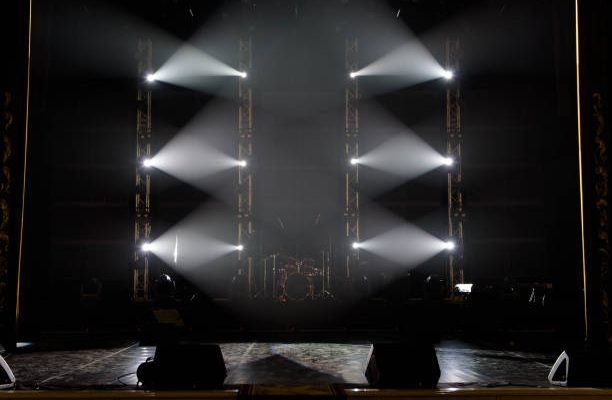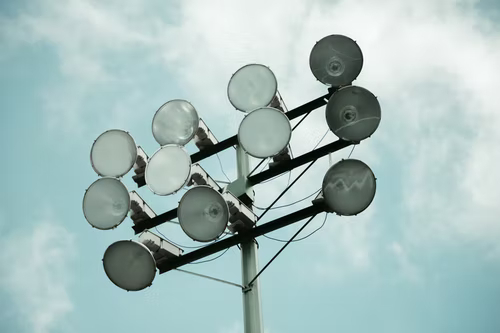LED stadium lights and traditional lighting are both used to illuminate large audiences. There are some notable differences between the two. Instead of using a single, large fixture, traditional lights use many small fixtures known as luminaires. These light fixtures usually stand on their own or in arrays called clusters. An array can consist of several rows and columns of lamps. Each lamp produces its amount of light that must be measured to develop a lighting design for the venue. Since these lamps release their light in every direction, lights must be placed throughout the audience area rather than clustered at the venue’s top, as common with most other lighting types.
What exactly is stadium lighting? How is it different from traditional lighting? This article will explain everything you need to know about LED stadium lights.
What is LED Stadium Lighting?
Stadium lighting is a type of LED lighting designed to illuminate large audiences. Unlike traditional lighting, which uses many small fixtures known as luminaires, stadium lights use a single, large fixture. This allows for a more even distribution of light throughout the audience area. According to folks at ledlightexpert.com, stadium lights should be placed at the top of the venue and not clustered throughout. This ensures that all audience members have an unobstructed view of the stage.
One of the biggest advantages of LED stadium lights is their energy efficiency. Traditional lights use a lot of electricity to produce light, while LED lights use much less. This can save you money on your energy bill and help to reduce your carbon footprint. Additionally, LED lights to last much longer than traditional lights, so you won’t have to replace them often.
Consider using LED stadium lights if you’re looking for a more efficient and environmentally-friendly way to light your next event. You’ll be able to save money and reduce your impact on the planet.
The Difference Between LED Stadium Lights and Traditional Lighting
LED stadium lights are more energy-efficient, longer-lasting, and glare less than traditional lighting. However, they are more expensive and may flicker more. Choose LED stadium lights for improved visibility and reduced maintenance costs. Choose traditional lighting for a more attractive light or for applications where flickering is not a concern. The debate about which type of lighting is better will continue as technology advances. However, for now, LED stadium lights are the clear choice for most applications.
Advantages of LED Stadium Lights
LED stadium lights have many advantages over traditional lighting. LED lights are more energy-efficient, longer-lasting, and produce less glare. Additionally, LED lights are more environmentally-friendly than traditional lights. Here’s a detailed explanation of each advantage:
Energy Efficiency:
LED stadium lights are more energy-efficient than traditional lighting. Traditional lights use a lot of electricity to produce light, while LED lights use much less. This can save you money on your energy bill and help to reduce your carbon footprint. With energy costs rising, choosing energy-efficient lighting is a smart way to save money.
Long Life:
LED lights last much longer than traditional lights, so you won’t have to replace them often. The lifespan of an LED light is typically around 50,000 hours. This means that an LED light can last for 11 years with proper care. Since LED lights last longer than traditional ones, you won’t have to replace them often. This can save you money on your maintenance costs.
Reduced Glare:
LED lights produce less glare than traditional lights. LED lights emit directional light, while traditional lights emit omnidirectional light. Directional light is easier on the eyes and reduces the risk of headaches and eye fatigue. This is especially important for large events where there is a lot of light.
Environmentally Friendly:
LED lights are more environmentally-friendly than traditional lights. LED lights do not contain any toxic materials, such as mercury. Additionally, LED lights are 100% recyclable. When you choose LED lights, you can feel good knowing that you are helping protect the environment.
Improved Visibility:
LED stadium lights provide better visibility than traditional lights. This is because LED lights produce a whiter light, easier on the eyes. Additionally, LED lights provide directional light, while traditional lights provide omnidirectional light. Directional light helps to reduce glare and improve visibility.
No Warm-Up Time:
Traditional lights need to warm up before they can reach their full brightness. LED lights, on the other hand, reach their full brightness immediately. This is beneficial in situations where you need to light up a space quickly, such as in an emergency.
Low Heat Emission:
LED lights emit very little heat, so they don’t require a lot of energy to cool the space. This makes LED lights more efficient than traditional lights. By reducing the amount of energy needed to cool the space, LED lights can help to lower your energy bill.
LED stadium lights are a more energy-efficient, longer-lasting, and environmentally-friendly alternative to traditional lighting. However, they are more expensive and may flicker more. Choose LED stadium lights for improved visibility and reduced maintenance costs. Choose traditional lighting for a more attractive light or for applications where flickering is not a concern.






















